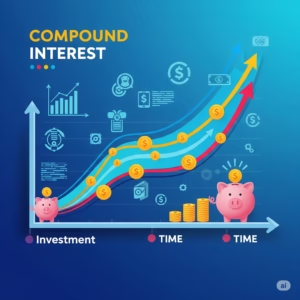
Investing can be an exciting journey toward building wealth, but it’s natural to feel a bit apprehensive about the “risk” involved. What exactly is investment risk, and how can you manage it without letting it paralyze your financial decisions? Simply put, investment risk is the possibility that your actual investment returns will differ from your expected returns. It’s the chance that you could lose some or all of your initial investment.

However, understanding and managing risk doesn’t mean avoiding it entirely. In the world of finance, some level of risk is necessary to achieve growth. The key is to understand the different types of risks and how to balance them with your financial goals and comfort level. This guide will break down the essentials of investment risk management in an easy-to-understand way, helping you invest with greater confidence.
What is Investment Risk, Really? Debunking Myths
Many people associate risk solely with losing money. While that’s certainly a component, investment risk is a broader concept. It encompasses various uncertainties that can impact your returns. For instance, the risk that a stock you own might not perform as expected, or the risk that inflation erodes the purchasing power of your returns.
Think of it like driving a car: there’s a risk of an accident, but you manage it with seatbelts, airbags, and careful driving. Similarly, in investing, you identify potential pitfalls and use strategies to mitigate their impact, rather than just avoiding the road altogether. Embracing a measured approach to risk is fundamental for long-term investment success.
Key Types of Investment Risk: What to Watch Out For
To manage risk effectively, it helps to know what kinds of risks exist. While the financial world has many nuanced types, here are some of the most common that everyday investors should be aware of:
Market Risk (Systematic Risk): The Tide That Lifts All Boats

Market risk is the risk that the overall market will decline, affecting most investments regardless of their individual characteristics. This is often driven by economic downturns, political instability, or major global events. For example, during a recession, the stock market as a whole might fall, impacting even financially sound companies. You cannot eliminate market risk through diversification, but you can manage its impact by investing for the long term and riding out short-term fluctuations.
Specific Risk (Unsystematic Risk): Company-Specific Challenges
Specific risk, also known as unsystematic risk, relates to the risk of a particular company or industry performing poorly. This could be due to bad management decisions, a product recall, new competition, or a change in consumer preferences. For instance, if you invest heavily in one technology company and it faces a major lawsuit, that’s specific risk. This type of risk can be significantly reduced through diversification.
Inflation Risk: The Erosion of Purchasing Power
As discussed in our article on inflation, inflation risk is the possibility that rising prices will erode the purchasing power of your investment returns. If your investments grow by 5% but inflation is 6%, you’re actually losing purchasing power. This risk is particularly relevant for fixed-income investments like bonds, where the interest payments are set. Managing inflation risk often involves investing in assets that tend to perform well during inflationary periods, such as real estate or certain commodities.
Interest Rate Risk: Impact on Fixed-Income Investments

Interest rate risk primarily affects bond investments. When interest rates rise, the value of existing bonds with lower fixed interest payments tends to fall. This is because new bonds are issued with higher yields, making older, lower-yielding bonds less attractive. If you need to sell your bonds before maturity when rates have risen, you could lose money. This risk is greater for long-term bonds.
Liquidity Risk: Can You Sell When You Need To?
Liquidity risk is the risk that you won’t be able to sell an investment quickly enough at a fair price when you need to. Some investments, like a publicly traded stock, are very liquid. Others, like certain types of real estate or private equity, can be much harder to sell quickly without taking a significant discount. For emergency funds or short-term needs, highly liquid investments are preferred.
Effective Strategies for Managing Investment Risk

Understanding risk types is the first step; the next is implementing strategies to manage them. You don’t have to be a financial expert to apply these powerful techniques.
Diversification: Your Best Defense Against Risk
Diversification is perhaps the most fundamental and effective risk management strategy. It means spreading your investments across various asset classes (stocks, bonds, real estate), industries, company sizes, and geographies. The idea is that if one investment performs poorly, others might perform well, balancing out your overall portfolio.
- Example: Instead of putting all your money into one company’s stock, invest in a broad market index fund that holds hundreds or thousands of different stocks. If one company struggles, its impact on your overall portfolio is minimal.
Asset Allocation: The Right Mix for You
Asset allocation is the process of deciding how to divide your investment portfolio among different asset categories, such as stocks, bonds, and cash.1 Your ideal asset allocation depends on your age, financial goals, time horizon, and risk tolerance. Younger investors with a longer time horizon might have a higher allocation to stocks (for growth), while those closer to retirement might lean more towards bonds (for stability). Periodically reviewing and rebalancing your asset allocation ensures it remains aligned with your goals.
Long-Term Perspective: Riding Out the Storms
One of the biggest mistakes new investors make is reacting emotionally to short-term market fluctuations. Markets go up and down; it’s a normal part of investing. By adopting a long-term perspective (thinking in terms of years and decades, not days or months), you can ride out periods of volatility and allow your investments to recover and grow over time. Trying to “time the market” (buying low and selling high consistently) is extremely difficult, even for professionals, and often leads to worse returns.
Dollar-Cost Averaging: Smoothing Out Volatility

Dollar-cost averaging involves investing a fixed amount of money at regular intervals2 (e.g., $100 every month), regardless of whether the market is up or down. When prices are high, your fixed amount buys fewer shares; when prices are low, it buys more shares. Over time, this strategy averages out your purchase price, reduces the impact of short-term volatility, and removes the emotion from investing. It’s a simple yet powerful way to build wealth consistently.
Professional Guidance: When to Seek Help
While self-education is important, don’t hesitate to seek advice from a qualified financial advisor. A professional can help you assess your risk tolerance, create a personalized investment plan, and guide you through complex market conditions. They can provide an objective perspective and ensure your risk management strategies are appropriate for your unique situation.
Investing with Confidence: Embracing Managed Risk
Investment risk is an inherent part of the wealth-building process. However, by understanding the different types of risk and implementing effective management strategies like diversification, appropriate asset allocation, and a long-term perspective, you can navigate the financial markets with greater confidence. Remember, the goal isn’t to eliminate all risk, but to manage it intelligently, allowing you to pursue your financial aspirations while safeguarding your hard-earned capital.





